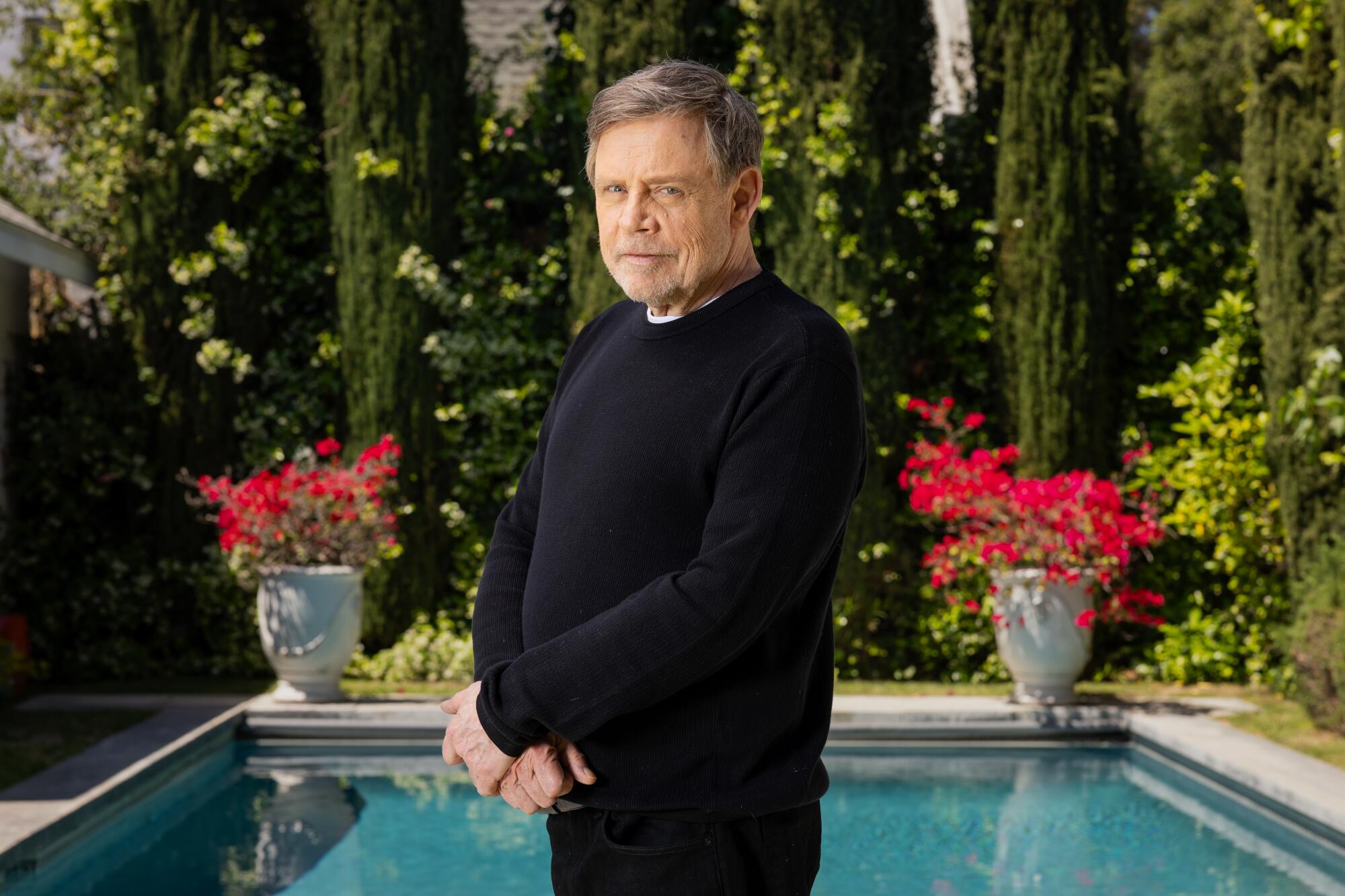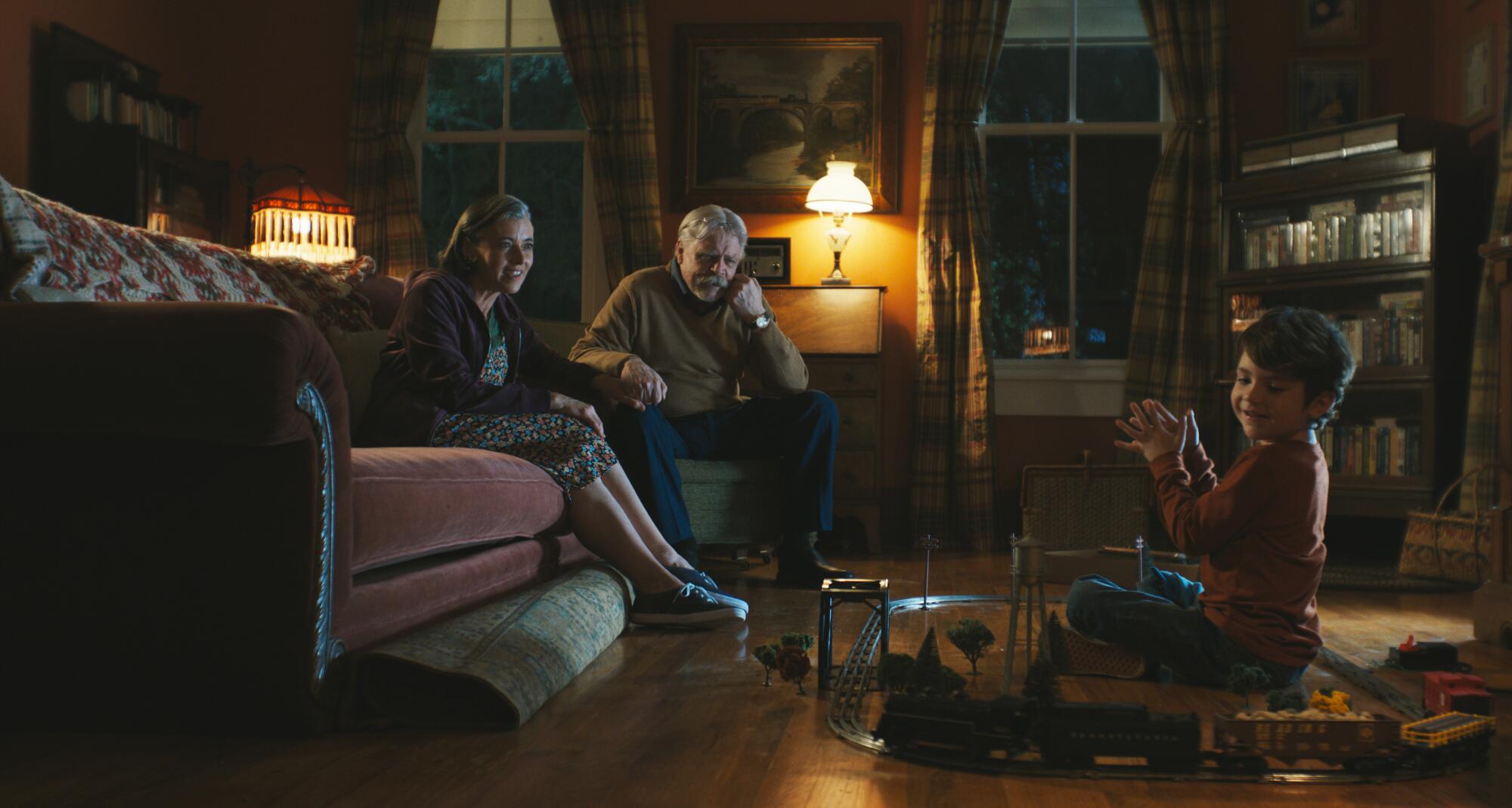
- Share via
Mark Hamill was at a point in his life where he felt ready to trade the Force for a pool float and a quiet crossword in the shade.
After five decades as the face of one of pop culture’s most enduring myths — Luke Skywalker, the wide-eyed Tatooine farm boy-turned-Jedi knight in “Star Wars” — Hamill had found a comfortable corner of the galaxy to call his own. He had a home he cherished, a family that kept him grounded and no pressing need to be in front of a camera again.
“I said, ‘This is perfect — they killed me off,’” Hamill, 73, says with a shrug on a warm May afternoon in Los Angeles, referring to Skywalker’s death in 2017’s “The Last Jedi.” “I didn’t have the drive or the motivation anymore. If you lose the fire in your belly, it’s easy to just hang around the pool all day, playing Yahtzee or whatever. I don’t want to be on camera at my age anymore. The only ones who complain are my agent and my wife. He wants the commission and she wants me out of the house.”
That was the plan, anyway — until the world caught fire.
The actor sits on a couch in a rented house in Los Feliz, his shoes kicked off to reveal socks patterned with the gloomy face of Edgar Allan Poe. His Malibu home — the one he bought with his “Star Wars” money in 1978, where he married his wife, Marilou, in the backyard and raised their three kids — remains uninhabitable after the January fires that tore through large swaths of the city, destroying most of his neighborhood. Hamill and his wife evacuated the Palisades fire as flames rose on either side of the road. “Every house that touches our property, except for one, burnt to the ground,” he says. “Two hundred and seventy houses — 60 survived.”
Four months later, the hills around his home are still blackened and toxic. And it’s not just his neighborhood that feels scorched. To Hamill — one of Hollywood’s most outspoken and sharp-tongued Trump critics — the country itself feels battered, just months into a second term he sees as a dangerous backslide. For a man who embodied the triumph of good over evil nearly half a century ago, it’s not always easy to find a new hope.
“I mean what a world — you had the pandemic and then you have what happened in politics, then you have this ghastly event,” he says. “It’s hard to say, ‘Oh, yay. I’m so happy our house survived’ when you realize all your friends lost everything.”
That sense of quiet disorientation — of a world slowly unraveling — pulses through “The Life of Chuck,” director Mike Flanagan’s strange and tender adaptation of a 2020 Stephen King novella. Following a warmly received premiere at last year’s Toronto International Film Festival, where it won the People’s Choice award, the Neon film hits theaters Friday as an unexpected — and somewhat risky — piece of summer counterprogramming: a hushed, reflective character study that begins with the end of the world and moves backward into a life-affirming meditation on memory, mortality and legacy.
Starring opposite Tom Hiddleston and Chiwetel Ejiofor, Hamill plays Albie, a widowed, math-loving Jewish grandfather facing the end of his life with quiet grace and stubborn decency — a role that, in an earlier era, might have gone to the likes of Richard Dreyfuss, Peter Falk or Judd Hirsch. It’s hardly the kind of part most people associate with Hamill, who has spent much of his post-”Star Wars” career behind the mic as a versatile and in-demand voice actor, most famously as the Joker in “Batman: The Animated Series” and numerous other TV and video game projects. But when Flanagan, who had previously cast him as a ruthless lawyer in the Netflix horror miniseries “The Fall of the House of Usher,” offered him the role, Hamill didn’t hesitate, at least not outwardly.
“Mark said something no actor has ever said to me: ‘I don’t know if I can do this, but you think I can do this, so I should,’ ” Flanagan says by phone. “That knocked me out. I felt like I had to rise to that level of trust.”

On set, Hamill fully inhabited the role. Albie doesn’t show up until more than an hour into the film and appears in only a few scenes, but he anchors the movie as a quiet, steady presence who finds comfort in routine, ritual and his lifelong love of numbers. To build his character’s look, Hamill asked the hair and makeup team to bleach out all the color from his hair and mustache, then tried on a few pairs of glasses. When he saw the result in the mirror, he cracked up: “Oh my God, I’m Geppetto. I look just like the Disney version.”
Hamill was drawn to how understated the role was — a far cry from the larger-than-life or eccentric characters he has often played in animation and genre fare. “He’s just sort of an amiable grandpa,” Hamill says. “You know, loves his wife, loves his grandchild, but you tell him you think math is boring, boy, it sets him off. You found his sore spot. I love the fact that he just loves being an accountant, loves math, which, for me, is a character part, believe me.”
The film’s emotional centerpiece is a long monologue Albie delivers alone at a desk: a quiet meditation on the hidden beauty of math and, by extension, life. Hamill, who hasn’t often had the chance to deliver this kind of grounded, dramatic work on screen, approached it with some trepidation.
“First of all, speeches are notorious — they go on for like three pages,” he says. “Luckily, I had it five or six weeks before we were going to shoot and I worked on it every single day.”
The grandfatherly on-screen role is a far cry from the one Hamill has played off-screen in recent years, where he’s become one of Hollywood’s most vocal and scathing critics of Trump. On X, where he has 4.7 million followers, he has channeled his pop-culture savvy and political outrage into a satirical sideshow, firing off punchlines like proton torpedoes.
On May 4, Star Wars Day, he mocked a White House post featuring an AI-generated image of Trump holding a red lightsaber, the canonical weapon of the franchise’s villains. “Proof this guy is full of SITH,” Hamill wrote on Bluesky, triggering a meme storm of Sith-Trump mashups.
Proof this guy is full of SITH.
— Mark Hamill (@markhamillofficial.bsky.social) 2025-05-04T19:44:09.954Z
Hamill is well aware his political outspokenness can easily steal the spotlight, but he can’t help himself, even during this interview. “I didn’t want to talk about politics — I know when I talk about it, that’s the headline,” he says right before launching into a full-throated excoriation of Trump. “I don’t think of myself as an activist,” he says. “But when they started using that phrase, ‘the Resistance,’ I thought, Jesus, I did that in a fictional way all those years ago. Now it’s the real thing.”
The impulse, he says, is both emotional and tactical. “I read a book that had, like, 37 psychiatrists talking about Trump’s malignant narcissism and they said people like that, their kryptonite is being laughed at,” says Hamill, a lifelong comic-book fan who often speaks in superhero metaphors. “So that informs my position. He’s so manipulative, I know if I tweeted something in praise of him, I’d have an invite to Mar-a-Lago. But no, thank you.” (Hamill has visited the White House three times, under Carter, Obama and Biden.)
Hamill knows his online habits aren’t always healthy. He tracks his follower count obsessively, noting it dropped by about 70,000 after Elon Musk took over Twitter, and now spends most of his time on Bluesky. “I never block people because I don’t want to give them the satisfaction,” he says. “But I mute like a mofo — mute, mute, mute. One time I looked at the clock and thought, ’Oh, my God, I’ve been muting people for 45 minutes.’” He sighs, then laughs dryly. “Harrison Ford is smart — he’s not on social media.”

Hamill, who has described his own father as a “Nixon Republican,” knows “Star Wars” was meant to be universal, a mythic tale of good and evil that fans across the political spectrum could embrace. Now, with many viewing him as a real-world member of the Resistance, he finds himself in a delicate spot.
“I’m sure I meet MAGA people all the time,” says Hamill, who jokes that he supports “MANA: Make America Normal Again.” “Even if they had a MAGA button, I wouldn’t be in conflict. A fan’s a fan. If it weren’t for them, I wouldn’t be where I am.”
Politics may dominate his social media feed but “The Life of Chuck” helped remind Hamill that acting still feeds something deeper. Now he is carrying that momentum into a handful of new projects. In September, he co-stars in another King adaptation, “The Long Walk,” a dystopian thriller set in a near-future America, where 50 teenage boys are forced into a harrowing nationally televised endurance contest: keep walking without rest, or be shot on sight — until only one remains.
“When I read the premise, I told [director] Francis [Lawrence], it’s like a thinking man’s snuff film,” he said. “It’s so horrific, I didn’t know if I could even see it, forget about being in it.” But Hamill has always relished a juicy villain and, with its authoritarian themes, the role of the Major fit the bill: “The State is the heavy and I represent the State.”
In December, returning to his beloved voice work, he will bring the Flying Dutchman to life in the animated sequel “The SpongeBob Movie: Search for SquarePants.”
Flanagan, for one, hopes “The Life of Chuck” marks the beginning of a new chapter in Hamill’s on-screen career. “I’m glad I got to be in the front row for this one — not just as the director but also as a kid who grew up with my lightsaber,” he says. “Mark is a happy guy. He’s perfectly comfortable with his legacy. But I wonder, if he’d had more opportunities to really plumb those depths, what would we have seen? He’s not done. I can’t wait to see what he’s going to do next.”

Still, Hamill can imagine stepping away on his own terms. “As much as I appreciate a good entrance, a good exit is also something — something with dignity. Something where you’re not in the latest ‘Human Centipede’ sequel.” (Yes, he claims, that was a real offer.)
“I wouldn’t announce it,” he continues. “I mean, who cares? I’ll be a ‘Jeopardy!’ answer: ‘Who is Mark Hamill?’”
For now, his focus is on something closer to home: rebuilding. His Malibu house was spared, thanks in large part to a retired firefighter friend who stayed in the guesthouse during the evacuation and managed to extinguish embers that had ignited the wooden floorboards. But the fire left the property uninhabitable. He and his wife — who have made their rented place feel a bit more like home with a few family photos — are hoping to return sometime next year, though he knows the recovery will be painfully slow and some neighbors may never come back.
“I went back the day before yesterday and I saw all the destruction,” he says. “We didn’t go on to the property because you have to have a hazmat suit. It forces you to consider your own mortality. Well, if I’m really lucky, I’ve got 10 years.” He shrugs. “Maybe. I don’t know. I used to smoke and I loved fast food until Marilou banned McDonald’s in the ’90s. That’s all gone now. But, you know, priorities. As bad as it was, everybody was safe and that should be enough.”

In the days since the fires, Hamill has tried to stay philosophical about what was lost and what still matters. He’s not particularly sentimental about memorabilia. But when the fires came, he realized there were still things he wasn’t ready to lose.
“I have the helmet I wore when I rescued Carrie,” he says, with a mix of wistfulness and a fan’s genuine awe, referring to the Stormtrooper disguise Luke donned to free Princess Leia, played by Carrie Fisher, from the Death Star. “It’s taped up, the rubber’s falling apart. I was lucky enough to be there at the very humble beginning of what George [Lucas] called ‘the most expensive low-budget movie ever made.’ But it has nostalgia value. Just this pitiful hunk of plastic that used to be something important.”
For the record, it still is.
More to Read
Only good movies
Get the Indie Focus newsletter, Mark Olsen's weekly guide to the world of cinema.
You may occasionally receive promotional content from the Los Angeles Times.










